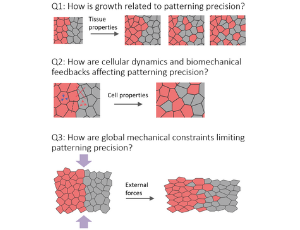Pursuant to § 7 sections 1 and 3 of Resolution No. 5/I/2020 of the Senate of the Jagiellonian University of 29 January 2020 on: the rules of recruitment for the Doctoral School of Exact and Natural Sciences at the Jagiellonian University in the academic year 2020/2021, the Director of the Doctoral School of Exact and Natural Sciences announces a competition for 1 doctoral student/s with a scholarship financed from the research project funds as part of the PhD study programme biophysics.
Within the PRELUDIUM BIS project entitled Nanospectroscopic investigation into DNA local structural transitions upon oxidative damage and its repair, a commission set up at the School will conduct recruitment for the PhD study programme biophysics in the academic year 2020/21.
The project manager, dr hab. Ewelina Lipiec offers an opportunity to complete the doctorates in the following area: Nanospectroscopic investigation into DNA local structural transitions upon oxidative damage and its repair
Detailed information on the project is provided by the project manager - dr hab. Ewelina Lipiec (Ewelina.Lipiec@uj.edu.pl)
An abstract of the project is attached to this announcement.
After the interviews and the evaluation of the candidates, the Chairman of the committee presents a report to the Director containing a list of candidates recommended for admission to the school as part of the research project.
Schedule of the competition:
- Opening of the competition: 02.09.2021
- Application submission deadline: 18.09.2021
- Entrance exams: 20-22.09.2021
- Announcement of results: 24.09.2021
- Enrolment: 27-28.09.2021
- Enrolment (additional): 30.09.2021 Detailed terms and procedures of admission.
Application documents:
- CV
- copy of the Master's degree (or equivalent) diploma
- a certificate of average grade in first cycle studies and a certificate of average grade inthe first year of supplementary master studies (second cycle) or for candidates who have completed five-year master studies a certificate of average grade in the last year of studies excluding the last year of studies
- letter of motivation
- copies of documents confirming competences and scientific achievements.
Please send your application documents to the project manager, dr hab. Ewelina Lipiec: Ewelina.Lipiec@uj.edu.pl and upload them into the Online Application System (irk.uj.edu.pl).
Documents required for entry within PhD study programme biophysics:
the original OAS application printed out from the system, containing a photograph;
a photocopy and the original for inspection of: a diploma or other document of graduation of a higher education institution abroad entitling the holder to undertake education in order to obtain the degree of doctor in which it was issued, recognised as equivalent to the relevant Polish master's diploma, and if, by the date of entry, the candidate does not yet hold a master's diploma document, a certificate issued by the higher education institution confirming that the candidate has passed the diploma examination, containing information on the right to take up education in order to obtain the degree of doctor in whose system the institution operates, with the grades given from the diploma examination, from the diploma thesis and on the diploma (for graduates of the second degree studies also a certificate containing these grades from the completed first degree studies);
- a photocopy and the original for inspection: a diploma supplement;
- for inspection: identity document (passport in case of foreigners);
- copies of documents confirming competences and scientific achievements,
- originals of all other documents provided at the registration stage in the form of a scan.
In the event of exposure to harmful, noxious or hazardous factors, the applicant will, at the time of registration, be referred for a medical examination by an occupational medicine physician. The candidate shall be obliged to deliver, within the time limit set by the programme manager, a medical certificate confirming the absence of contraindications to take up education (applies only to some PhD study programmes).
Higher education diplomas awarded abroad should:
- bear an apostille clause if the issuing country is covered by the Convention abolishing the requirement legalisation for foreign public documents, done at The Hague on 5 October 1961 (Journal of Laws of 2005, No. 112, item 938) or
- be subjected to legalisation, in other cases.
Any document submitted in a language other than Polish or English must be accompanied by a certified translation into Polish or English.
Insurance:
Each doctoral student, including a foreigner, admitted to the doctoral school is obligatorily subject to health insurance if he/she is not covered by such insurance on other grounds (e.g. employment relationship, contract of mandate, business activity, insured as a family member under 26 years of age, as the spouse of an insured person). The health insurance contribution is paid by the Jagiellonian University and is financed from the State budget. In addition, a doctoral student receiving a doctoral scholarship is subject to compulsory retirement and disability insurance and accident insurance.
IMPORTANT:
A person admitted to the doctoral school begin education and acquire doctoral student rights upon taking the oath. The Department of Personal Affairs reports each doctoral student admitted to the School to compulsory health and social insurance at the commencement of education. Until that time foreign candidates are obliged to cover the costs of insurance for the time of travel, treatment, etc. individually.
Abstract:
Each cell has to continuously repair DNA damage. Even tens of thousands of DNA lesions occur in one cell per day. Particularly noteworthy is oxidative damage (caused by reactive oxygen species, mainly hydroxyl radicals) resulting from oxidative stress, which is important in many civilization diseases such as atherosclerosis, Alzheimer's disease, or Parkinson's disease. Various types of abnormal modifications of DNA structure, the so-called DNA damage, could be formed: modifications of DNA bases, pyrimidine dimers formation, through covalent bonds between bases called cross-links. Damaging factors may also interrupt one or both DNA strands leading to single strand breaks (SSBs) and double strand breaks (DSBs), respectively. DSBs are extremely dangerous. Unrepaired DSBs may cause mutations, chromosomal aberrations and even cellular death. Therefore, cells developed several very complex mechanisms to repair the DNA damage. Proteins responsible for the repair of DNA damage are well known. However, many fundamental aspects of DNA – proteins interaction upon DNA repair process still require further research. Methodological limitations prevented or largely prohibited direct measurements that would provide information about structure and composition of DNA-protein complexes as well as the molecular modifications of DNA itself. DNA structure may be locally modified (local conformational change) upon strand break or interaction with repair proteins. This change determines DNA reactivity with a particular repair protein.
Here, a deep investigation into the influence of DNA conformation and chromatin integrity on the susceptibility to DNA damage formation and the efficacy of its repair is planned. To verify local molecular structure, an application of extremely sensitive analytical technique called tip-enhanced Raman (TER) spectroscopy and also TER spectral mapping supported with other analytical techniques to damaged DNA/chromatin and DNA/chromatin-repair protein complexes is planned. TERS is a combination of Atomic Force Microscopy, allowing an imaging of the studied molecules (here DNA and repair proteins) and Raman spectroscopy enabling the analysis of chemical structure. TERS provides information about chemical structure and composition with nano-metric spatial resolution. Precisely, I am planning to follow DNA conformational modifications upon oxidative damage induction with hydroxyl radical and interaction with repair proteins such as DNA ligase IV and MutS.
Additionally, infrared and Raman spectroscopies will be applied to detect DNA damage in cells as well as a hallmark of cellular response to induced DNA oxidative damage. Infrared spectroscopy will be applied in studies of living cells and isolated nuclei. Individual chromosomes, nuclei and cells will be also mapped by Raman microspectroscopic imaging. In cells treated with H2O2 as well as nuclei and
chromosomes isolated from them, we expect to observe an increase of protein expression and DNA conformational change associated with the DNA repair process.
Summarising, this project includes complementary studies at various levels of chromatin integrity: single DNA strands and chromatin fibers, as well as chromosomes, cellular nuclei and cells. Appropriate analytical techniques and imaging methods were carefully selected to each of the above-mentioned samples to obtain complementary information related to the role of DNA conformational changes in DNA damage formation and repair. An integral part of this project is an application od multivariate data analysis for simultaneous treatment of all the acquired data for comprehensive comparison of all micro- and nanospectroscopic markers (characteristic marker bands) associated to DNA damage and repair.
This Project involves significant development of experimental methods, in particular an implementation of TERS technique for measurements in liquid. This will be beneficial for other researchers, who will apply the optimised methodology in deep investigation into many biologically significant systems.



